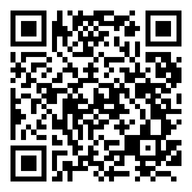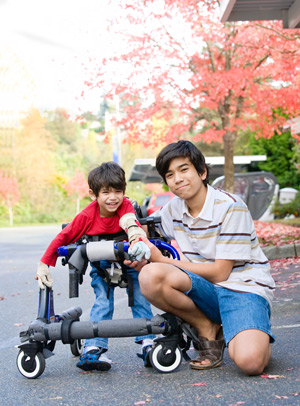Overview
Cerebral Palsy (CP) is a general term for damage to the parts of the brain that control muscle activity. Movement and coordination are often affected. The disability can be mild, moderate, or severe. Some children can walk by themselves. Others need help from braces, crutches, walkers, or wheelchairs.
Symptoms
Children with CP may be slow to meet developmental targets such as rolling over, sitting up, crawling, and walking. Your child may demonstrate other symptoms. CP may affect may body systems other than motor skills. For example:
- Developmental delay including learning disabilities or speech problems
- Seizures
- Vision or hearing difficulties
- Problems with teeth, swallowing, or constipation
- Curvature of the spine (scoliosis)
- Joint contractures or hip dislocations
Evaluation & Examination
Early signs of CP include being late in learning to roll over, sit up, crawl, or walk. Sitting up by oneself usually happens between 6 and 8 months of age. Walking by yourself usually starts by 18 months of age. If your child is slow to do these things, you should ask your pediatrician about possible developmental delay. Pediatric neurologists (brain and nerve doctors) and/or pediatric orthopedic surgeons also help with the evaluation and diagnosis.
Your doctor will look at your child’s muscle tone and reflexes. He/she will also check the range of motion of the joints. He or she will also watch to see what your child can do, such as sitting, crawling, and using the hands. Watching your child walk is also an important part of the evaluation.
Many times, no other tests are needed to evaluate for CP. Sometimes your doctor will order a magnetic resonance imaging (MRI) test of your child’s brain to look for abnormalities.
Treatment
In the early years (before the age of 3), treatment is to help the child gain his/her milestones like walking. Early intervention programs (EIP) offer physical therapy (PT), occupational therapy (OT), and speech therapy (ST). As the child reaches school age, treatment shifts to keeping function. For example, PT helps keep the joints moving and improves strength, while braces and assistive devices (crutches, walkers, wheelchairs) help the child join in with his/her classmates. When your child is older, treatment options may include surgery.
Special Treatment Options
Special shoes are rarely needed.
Braces are a very important part of treatment. Braces can help keep your child’s feet flat on the ground. This can help him/her feel more stable and can help prevent foot problems. Braces also can help keep the muscles stretched out, which sometimes avoids the need for surgery.
Medications are sometimes used to decrease spasticity.
Onabotulinumtoxin A (Botox) can be helpful in some patients. It is useful to help stretch tight muscles in patients with full motion in their joints. In other words, Botox will not help if the joints themselves are stiff.
Stem cell injections are NOT an approved treatment in the United States for CP. The FDA offers current information on the
state of stem cell research.
Operative Treatment
Keep in mind that CP is a term that includes many kinds of patients with different problems. It is difficult to guess if your child will need surgery. Every child with CP is different. When doctors do recommend surgery, it is rarely performed before 6 years of age. When appropriate, most pediatric orthopedic surgeons agree that an ideal time to perform surgery is between 7 and 12 years old. Procedures can include tendon lengthening, moving tendons from one muscle to another, or cutting the bone to re-align it. Some patients benefit from a pump that delivers medicine to the fluid around the spine. This medicine, known as baclofen, relaxes muscles. Cutting selective nerves in the lower spinal cord may also help to relax the muscles. This is known as a dorsal rhizotomy.
Prognosis
Your child - and your child’s CP - is unique, so you will need to discuss your child with your doctors. There are still some common, expected facts about your child’s growth and development. Most children with CP will have delayed milestones - walking later than other children, for example- but will continue to show improvement until about 6 years of age. Your child’s function may remain the same in the early school years. When your child enters the teenage years and starts to grow taller and heavier, his/her muscles may have a harder time functioning due to the increased forces required. Because of this, your child may seem to have worse function.
More information
Your local doctors can direct you to information and resources specific to your area. The American Academy of Cerebral Palsy and Developmental Medicine (AACPDM) is an organization that focuses on the well being of people with cerebral palsy and other childhood-onset disabilities. Visit
aacpdm.org for more information.
More Information
OrthoInfo - Cerebral Palsy
I'm a HIPpy - Cerebral Palsy
Condition QR Code:


 POSNA.org
POSNA.org

